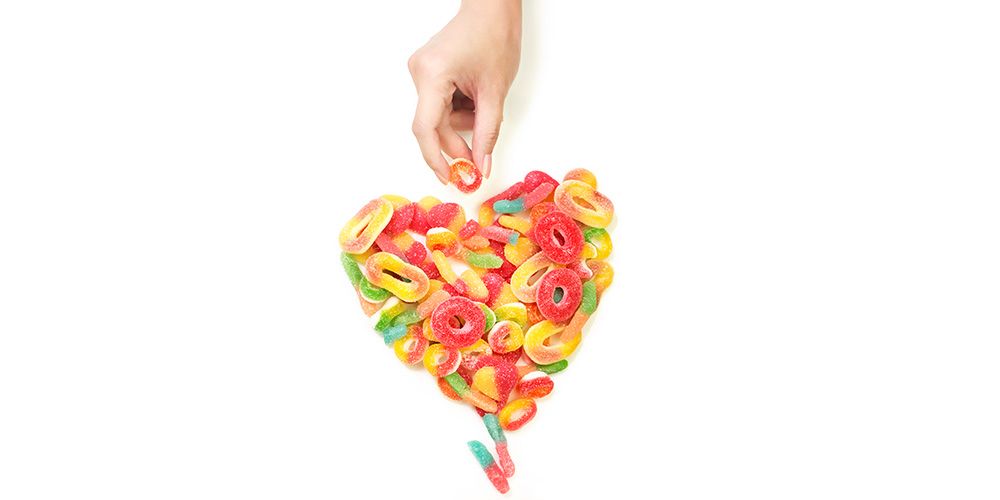Emotional eating is often seen as a shameful act we have to hide (sometimes literally) and punish ourselves for later in the gym. But emotional eating is a thing humans do—because we eat and we have emotions and sometimes a cookie does just make you feel better. Hey, not even the nutrition pros are immune to a little chocolate therapy sometimes.
“Even though I’m a dietitian, I’ve definitely eaten emotionally,” says Rebecca Scritchfield, R.D. and author of Body Kindness. Her emotional eating stems from a childhood where she was only allowed to be “happy” and all negative emotions had to be stuffed down inside. So instead, she says she learned to deal with feelings like sadness and anger by chronically dieting and eating diet junk food like spray butter, Snackwells cookies, and Diet Coke.
But just because emotional eating is normal doesn’t mean you want to do it all the time. Plus, the cookie only helps for a few minutes and you’re still left with the underlying issues when you’re done. The trick to overcoming the need to use food to manage your emotions is to learn to treat your body—cravings and all—with kindness, Scritchfield says.
“To break my cycle of emotional eating, I had to stop dieting completely, learn mindfulness and yoga, and most of all, self-compassion,” she says.
Knowing you’re eating out of emotion and not true hunger is the first step, she says, but there are as many different ways to deal with emotions as there are women having them. For Scritchfield that means using a technique she calls “spiraling up,” a method of visualizing emotions to regulate them—instead of turning to cookies or chocolate. For other women, however, it involves meditation, therapy, exercise, or even ritualistic hand tapping. Read on to see what helped these ladies manage their own emotional reactions to food.
“I went into therapy, I started practicing yoga almost daily, and I took a 10 week course in mindful eating, which included literature by Geneen Roth, lots of exercises, coaching, journaling, meditations, etc. I had been eating emotionally since I was a teenager, that is for more than 20 years. Finally, it stopped. This was in 2011 and I have not fallen back into emotional eating yet. I am so grateful.” —Emma S., Quebec, Canada
“I used to eat when I was sad, mad, bored, or even happy. To end this cycle of mindless eating, every time I went to eat something I would ask myself, ‘Am I eating because I’m hungry or because I am feeling a certain emotion?’ That helped me recognize that I was eating emotionally. That didn’t stop the craving though, so I would follow that up by drinking eight ounces of water and waiting 10 minutes. If I was still hungry after that I would eat something small to tide me over until meal time. I still have to do this almost every day so I don’t snack myself to death.” —Amanda S., Denver, CO
“For me, the key to quitting emotional eating was to realize that it’s okay to eat emotionally sometimes. I decided I could still eat what I wanted but only after I identified the emotion and the real reason I wanted the food—and ‘tired’ or ‘stressed’ wasn’t enough. I had to dig through the layers until I realized what was really going on. For instance, ‘I’m tired and I’ve been doing things for others all day and haven’t done anything for me, and the 10 minutes it will take me to eat these cookies are the only thing I’ll have enjoyed today, even though I’ll feel sick later.’ And then I would eat the cookies if I still wanted them. Over a few months, I basically got more comfortable feeling uncomfortable emotions and my desire to inhale Oreos decreased in correlation. The day a package went stale and I had to throw it out was a huge victory!” —Marste M., Murrieta, CA
“To help me stop eating emotionally I use a program called EFT, or Emotional Freedom Technique. It involves tapping certain areas of the body gently with your fingers in a specific pattern. I know it sounds kind of ‘woo-woo’ and out there but it works! It’s really helped me get in tune with my body’s signals.” —Alyssa Z., Los Angeles, CA
“I was working through my anxiety and depression issues with a therapist who specializes in cognitive behavioral therapy (CBT) and through this process I discovered that my relationship with food was not healthy. Continuing CBT helped me define my emotional-eating issues and gave me the tools to work through them.” —Kris K., Maplewood, MN
Watch a hot doc explain whether your anxiety is serious:

“The books Intuitive Eating by Elyse Resch and Evelyn Tribole and Health At Every Size by Linda Bacon have changed how I think about eating. They show how our diet and weight-loss culture contributes to disordered eating. They are also great guidebooks for beginning and continuing to work on intuitive eating. For example, they taught me how to recognize what it actually feels like to be physically hungry and how to identify the foods that feed my whole self and not just my cravings.” —Kris K., Maplewood, MN
“There is an app called Recovery Record that is designed for folks in eating disorder recovery (although you don’t have to be recovering from an eating disorder to use it). I like it because it has me rank my physical hunger and track my meals so I could see the relationship to what, how often, and how much I ate in relation to my hunger level. It doesn’t involve any kind of calorie counting or weight-loss markers but rather teaches you how to eat in a way that truly satisfies hunger.” —Kris K., Maplewood, MN
“I met with a registered dietitian just to get a refresher on the basics of food and nutrition. Part of my emotional eating was confusion over what real nutrition was thanks to years of dieting, emotional eating, and restricting food. It was good to get a fresh, clear picture of what components I should look for in my meals and snacks.” —Kris K., Maplewood, MN
“A part of my emotional eating was tied to my body image so I did a bunch of work on body and size acceptance. My yoga practice was particularly useful here as was working out with my trainer. These helped me to find joy in movement and gave me a great new perspective on exercise. I learned fitness is a lot more enjoyable when you’re doing it to feel strong and have fun than it is when you’re doing it to punish yourself for what you’ve eaten.” —Kris K., Maplewood, MN
(Torch fat, get fit, and look and feel great with Women’s Health’s All in 18 DVD!)
“I have been doing a Bible study program called ‘Taste for Truth.’ It uses Biblical principles to help people manage their diet. I wouldn’t say I have 100 percent conquered my emotional eating, but it is really helping.” —Julie S., Allen, TX
“Reading The Chemistry of Joy by Henry Emmons totally changed the way I see food. It taught me about the chemical reactions that happen when you eat certain foods, like sweets actually stimulate your pleasure center. This empowered me to change my eating habits, knowing it wasn’t a lack of will power or personal failure that made me crave things. Emotional cravings are a natural response to that feeling and it makes sense but there are other ways to deal with them. For instance, it gave me so many tips on how to add in serotonin-rich foods to help nip cravings before they start.” —Jeni S., Minneapolis, MN
“I used to eat emotionally a lot but then I was diagnosed with dysautonomia, an umbrella term that describes a number of problems with the nervous system. Part of the disorder means I need a lot more salt than the average person and now I eat a very high-salt diet. It made me realize that a lot of what I thought was emotional eating tied to anxiety and depression was actually a true need for salt. Now, I recognize that I’m really craving salt and go directly for something salty rather than eating whatever might sound good. It’s made a big difference in what I used to just deem emotional eating.” —Megan H., Ridgecrest, CA
“For me, the trick to not eating emotionally is simply to not have certain foods in the house. Some foods are triggers for me to binge on when I’m feeling emotional and I’ve learned it’s best if I don’t have them easily available.” —Jana J., Brooklyn, NY
“If I feel hungry at a time I am not normally hungry, I know that it’s likely an emotional craving. So instead I make a cup of tea and drink it. If I am still hungry after that, I try and have a healthy snack. I also make it a point to just have a treat sometimes so I don’t feel deprived. Depriving myself of treats just makes me binge on forbidden foods.” —Heather N., Saskatoon, Canada
“I’ve discovered that alcohol is tied to my emotional eating so I made a rule that I can’t snack if I’m drinking unless it’s an actual mealtime. Otherwise I’ll always eat too much.” —Heather N., Saskatoon, Canada

